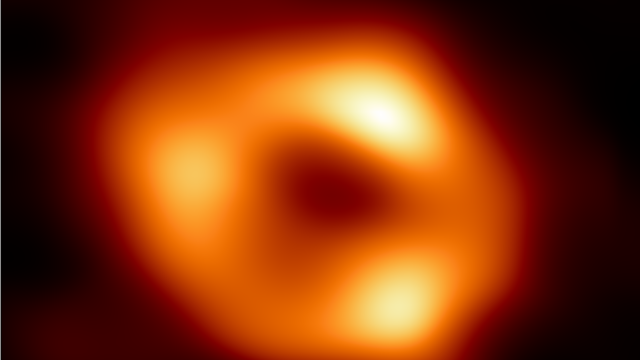The fuzzy, bright-orange trappings of a cosmic beast that lurks in the heart of our galaxy made quite the impact today on scientists and space nerds alike. The Event Horizon Telescope (EHT) Collaboration released its first image the black hole at the centre of the Milky Way, known as Sagittarius A*, in another major scientific milestone.
The group released the first image of a black hole — a distant monster called Messier 87* — in 2019, and now they’ve turned their telescopes closer to home. Sagittarius A* (pronounced “A-star”), a source of radio waves at the centre of our galaxy, has long been assumed to be a supermassive black hole. Now, we know it for sure.
“The wait is over. Meet the black hole at the centre of our galaxy,” Feryal Özel, EHT modelling lead and a professor of astronomy and astrophysics at the University of Arizona, announced on Twitter Thursday morning with the hashtag #OurBlackHole.
Astronomers have been waiting for this moment since they laid eyes on the shadow of M87* back in 2019.
Becky Smethurst, an astrophysicist at the University of Oxford, recorded her live reaction to seeing the image of Sagittarius A* and posted the video on YouTube. “Oh my god, look at it,” Smethurst exclaims. “It’s so much more squashed than M87.”
Sagittarius A* is about a thousand times smaller than the M87 black hole, weighing in at only 4 million times the mass of the Sun. It also looks quite a bit more like a doughnut, as some astronomers pointed out through a series of mostly Homer Simpson-related memes.
Astronomers today. pic.twitter.com/0mKSgfPrus
— Astro Plot of the Week (@PlotAstro) May 12, 2022
🍩 SgrA* pic.twitter.com/Z4RtFJMx3J
— Observatorio ALMA📡 (@ALMAObs_esp) May 12, 2022
Others chose to put an astrophysics twist on an old classic.
— Dan Galletti (@GallettiMan) May 12, 2022
Meanwhile, some scientists aimed to show the scale captured in the image. Mark McCaughrean, senior advisor for science and exploration at the European Space Agency, noted the size difference between the radius of Earth’s orbit around the Sun and the radius of the black hole in the image.
My attempt to give some scale to the @ehtelescope image of the Sgr A* black hole in the centre of our Milky Way.
Earth’s orbit around the Sun is ~150 million km radius, while Sgr A*’s Schwarzschild radius (or event horizon) is ~12 million km.
Sun & Earth dots are not to scale. pic.twitter.com/3oKKVs4jqe
— Mark McCaughrean (@markmccaughrean) May 12, 2022
Astrophysicist Jonathan McDowell from the Harvard-Smithsonian Centre for Astrophysics also felt the need to clarify why the image is seemingly blurry. “A lot of confusion about why the black hole picture seems blurry, but is actually one of the sharpest pictures ever taken. It’s because what you are seeing is super, super zoomed in,” McDowell wrote in a series of tweets.
Here’s a piece of that image zoomed in at the middle. Today’s EHT picture of the black hole is of an area ONE THOUSAND TIMES smaller than any of the pixels in this image. pic.twitter.com/NdSorCmwHd
— Jonathan McDowell (@planet4589) May 12, 2022
As the metaphorical confetti settles after the image release, scientists are excited to learn a whole lot more about these mysterious, fuzzy doughnuts in space.
